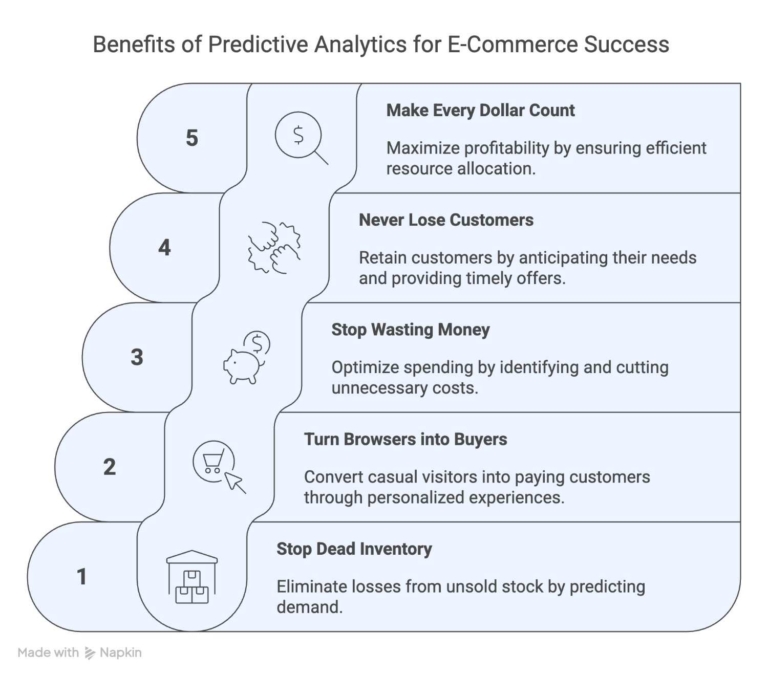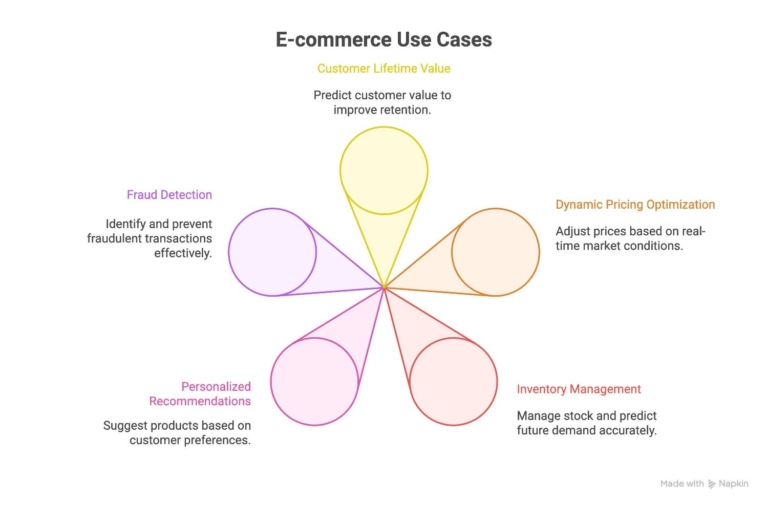Greetings! I'm Aneesh Sreedharan, CEO of 2Hats Logic Solutions. At 2Hats Logic Solutions, we are dedicated to providing technical expertise and resolving your concerns in the world of technology. Our blog page serves as a resource where we share insights and experiences, offering valuable perspectives on your queries.

Quick Summary
Predictive analytics uses historical data and machine learning to forecast customer behavior, inventory needs, and sales trends. For e-commerce businesses, this technology helps to increase revenue. This can be done through improved personalization, optimized inventory management, and enhanced customer retention strategies. Implementation of this requires clean data collection, appropriate tools, and strategic integration across marketing, operations, and customer service departments.
What Is Predictive Analytics?
Predictive analytics is a data-driven approach. It uses statistical algorithms, machine learning techniques, and historical data to predict future outcomes and behaviors. In traditional analytics, it tells you what happened. Predictive analytics forecasts what’s likely to happen next.
How can it be useful in the e-commerce context? It helps turn customer data into actionable insights. This is done by analyzing patterns from past purchases, browsing behavior, seasonal trends, and demographic information. It helps you make informed predictions about what customers are looking for in the market.
Core Components of Predictive Analytics
Take a look at the core components thats works in predictive analytics:
Data Collection: Historical sales data, customer interactions, website behavior, and external market factors serve as the foundation. According to McKinsey Global Institute, companies using customer analytics extensively are more likely to outperform competitors in new customer acquisition.
Statistical Models: Advanced algorithms including regression analysis, decision trees, neural networks, and ensemble methods process this information to identify patterns and correlations.
Machine Learning: Automated systems continuously refine predictions as new data becomes available, improving accuracy over time.
Identify your highest-impact predictive analytics opportunity
Major Benefits of Predictive Analytics for E-Commerce

Stop Losing Money on Dead Inventory
Imagine never having to mark down thousands of dollars worth of seasonal items that didn’t sell, or never running out of your best-selling products during peak demand. Predictive analytics tells you exactly what to stock and when.
Turn Browsers into Buyers
Instead of showing the same products to everyone, predictive analytics helps you show each visitor exactly what they’re most likely to purchase. It’s like having a personal shopping assistant for every customer. Amazon attributes 35% of its revenue to this approach. That means billions in sales from simply showing the right products to the right people.
Stop Wasting Money
Rather than blasting generic emails to your entire list and hoping for the best, predictive analytics identifies which customers are most likely to buy specific products. This means you can send targeted offers that actually convert.
Never Lose Another Customer to Poor Timing
Predictive analytics spots the warning signs before customers leave. This happens like when someone who usually orders monthly suddenly goes 6 weeks without a purchase. You can reach out with a special offer or check-in before they shop elsewhere. Netflix saves $1 billion annually by keeping subscribers engaged with personalized content recommendations.
Make Every Dollar Count
Instead of guessing which marketing campaigns will work, you’ll know which customers are worth investing in. Predictive models show you the lifetime value of each customer, so you can spend more to acquire high-value customers and avoid overspending on one-time buyers.
Potential Challenges and Limitations
Data Quality Requirements
Poor data quality can lead to inaccurate predictions. The “garbage in, garbage out” principle applies strongly to predictive analytics.
Implementation Costs
Initial setup costs for predictive analytics systems can range from $50,000 to $500,000 depending on complexity and business size.
Privacy Concerns
Increased data collection and analysis must comply with regulations like GDPR and CCPA, requiring careful privacy management strategies.
Technical Complexity
Organizations need skilled data scientists and analysts to implement and maintain predictive systems effectively.
Why Predictive Analytics Works for E-Commerce
E-commerce businesses generate massive amounts of structured data that predictive analytics thrives on. Every click, purchase, search, and interaction creates valuable data points that traditional brick-and-mortar stores simply cannot capture at the same scale.
The Digital Advantage of Predictive Analytics for E-commerce
Rich Data Environment: Online stores collect detailed behavioral data including time spent on pages, product views, cart abandonment patterns, and purchase sequences. This granular information provides the fuel predictive algorithms need to generate accurate forecasts.
Real-Time Processing: Digital platforms enable immediate data collection and analysis, allowing for dynamic pricing adjustments, instant personalization, and rapid response to changing market conditions.
Scalability: Cloud-based predictive analytics solutions can scale with business growth, processing increasing data volumes without proportional increases in infrastructure costs.
Customer Behavior Patterns: E-commerce customer behavior follows predictable patterns that machine learning models excel at identifying. Research by Salesforce indicates that 84% of customers say being treated like a person, not a number, is very important to winning their business.
Seasonal Trends: Predictive models can forecast demand spikes during holidays, back-to-school seasons, or industry-specific events, enabling proactive inventory and marketing planning.
Lifecycle Stages: Analytics can identify where customers are in their buying journey and predict their likelihood to purchase, return, or churn.
Need help optimizing your predictive analytics performance?
Practical Use Cases for E-Commerce Businesses

Customer Lifetime Value Prediction
Predictive analytics can forecast how much revenue each customer will generate over their entire relationship with your business. This insight helps prioritize customer acquisition efforts and personalize retention strategies.
Implementation Strategy: Analyze historical purchase data, engagement metrics, and demographic information to score customers based on their predicted lifetime value. High-value customers receive premium service and targeted offers, while at-risk segments get retention-focused campaigns.
Dynamic Pricing Optimization
Real-time price optimization based on demand forecasts, competitor pricing, and inventory levels can increase profit margins by 2-5%. Uber’s surge pricing model demonstrates how dynamic pricing can balance supply and demand effectively.
Application Method: Monitor competitor prices, track demand patterns, and adjust pricing in real-time based on predictive models that forecast optimal price points for maximum revenue.
Inventory Management and Demand Forecasting
Predictive analytics helps businesses maintain optimal inventory levels by forecasting demand for specific products, sizes, and variants. Walmart uses predictive analytics to optimize inventory across 10,500 stores worldwide.
Key Benefits:
– Reduce carrying costs by avoiding overstock situations
– Minimize lost sales from stockouts
– Optimize warehouse space utilization
– Improve cash flow through better inventory turnover
Personalized Product Recommendations
Recommendation engines powered by predictive analytics can increase average order value by 15-25%. These systems analyze customer behavior, purchase history, and product relationships to suggest relevant items.
Advanced Techniques:
– Collaborative filtering based on similar customer preferences
– Content-based recommendations using product attributes
– Hybrid approaches combining multiple recommendation strategies
– Real-time personalization based on current browsing session
Fraud Detection and Risk Management
Predictive models can identify potentially fraudulent transactions in real-time by analyzing patterns in purchase behavior, payment methods, and account activity.
Risk Factors:
– Unusual purchase amounts or frequencies
– Geographic inconsistencies
– Payment method anomalies
– Account creation patterns
– Device and browser fingerprinting
We Can Help You Implement Predictive Analytics
Our implementation process begins with a comprehensive data audit and business objectives analysis. We evaluate your current data infrastructure, identify key performance metrics, and develop a customized predictive analytics strategy aligned with your business goals.
We specialize in integrating predictive analytics solutions with popular e-commerce platforms including Shopware, Shopify, WooCommerce, Magento, and BigCommerce. Our approach follows a seamless data flow between your existing systems and new predictive capabilities.
Successful predictive analytics implementation requires ongoing support and team education. We provide comprehensive training programs to check whether your team can effectively interpret and act on predictive insights.
Conclusion
Predictive analytics represents a transformative opportunity for e-commerce businesses to gain competitive advantages through data-driven decision making. The technology’s ability to forecast customer behavior, optimize operations, and personalize experiences directly translates to increased revenue and improved customer satisfaction.
The businesses that embrace predictive analytics today will establish significant competitive advantages in the increasingly data-driven e-commerce landscape. As customer expectations continue to rise and markets become more competitive, predictive analytics transitions from a nice-to-have capability to a business necessity.
Contact our team of e-commerce analytics experts to schedule a free consultation and discover how predictive insights can drive your business growth.
Table of contents
- What Is Predictive Analytics?
- Core Components of Predictive Analytics
- Major Benefits of Predictive Analytics for E-Commerce
- Potential Challenges and Limitations
- The Digital Advantage of Predictive Analytics for E-commerce
- Practical Use Cases for E-Commerce Businesses
- We Can Help You Implement Predictive Analytics
- Conclusion

Related Articles







